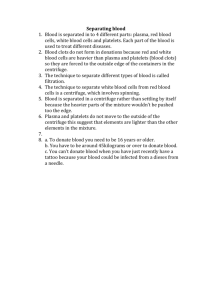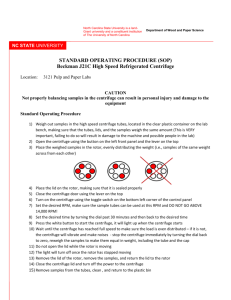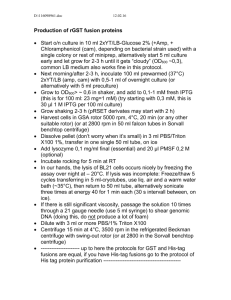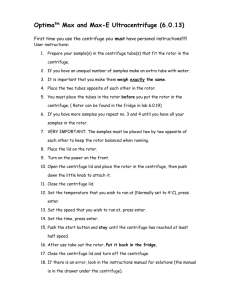Centrifuge Use and Maintenance
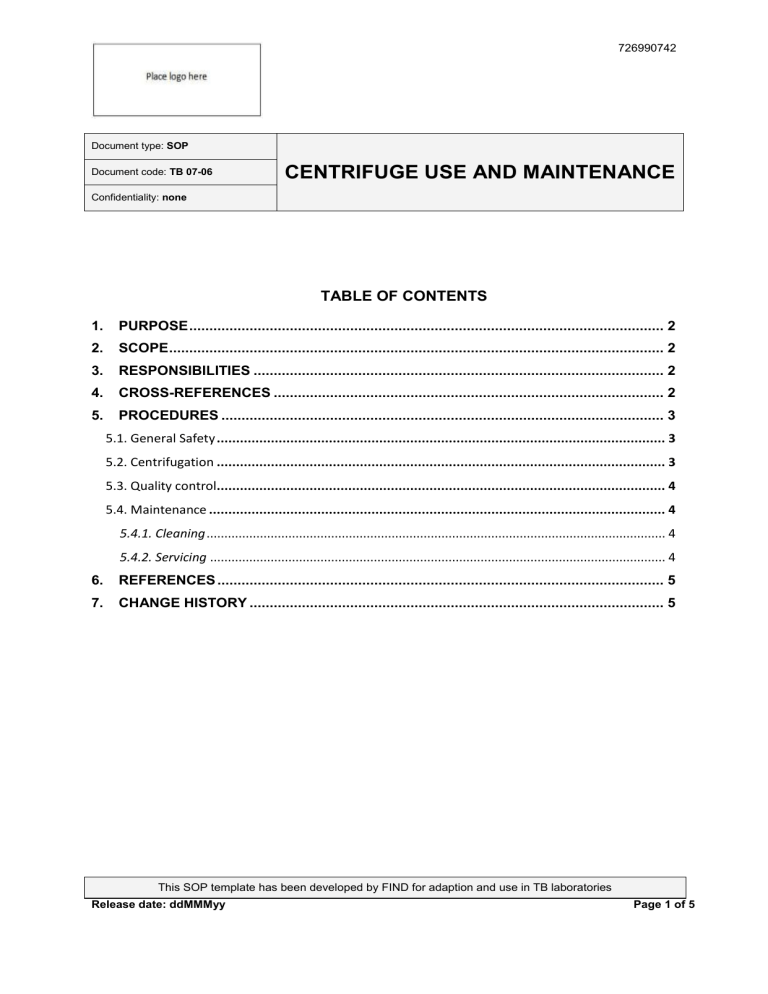
726990742
Document type: SOP
Document code: TB 07-06
CENTRIFUGE USE AND MAINTENANCE
Confidentiality: none
TABLE OF CONTENTS
1.
PURPOSE ...................................................................................................................... 2
2.
SCOPE ........................................................................................................................... 2
3.
RESPONSIBILITIES ...................................................................................................... 2
4.
CROSS-REFERENCES ................................................................................................. 2
5.
PROCEDURES .............................................................................................................. 3
5.1. General Safety .................................................................................................................... 3
5.2. Centrifugation .................................................................................................................... 3
5.3. Quality control .................................................................................................................... 4
5.4. Maintenance ...................................................................................................................... 4
5.4.1. Cleaning ................................................................................................................................. 4
5.4.2. Servicing ................................................................................................................................ 4
6.
REFERENCES ............................................................................................................... 5
7.
CHANGE HISTORY ....................................................................................................... 5
This SOP template has been developed by FIND for adaption and use in TB laboratories
Release date: ddMMMyy Page 1 of 5
1. PURPOSE
726990742
This operating procedure describes the use and maintenance of the centrifuge. Optimal operation of the centrifuge is achieved through regular servicing and preventive maintenance. A centrifuge is intended to separate particles in a liquid by sedimentation. Dense particles sediment first, followed by lighter particles. In a TB laboratory, centrifuges are used for the sedimentation of tubercle bacilli and their concentration within liquefied sputa or body fluids (usually urine).
To obtain a high sedimenting efficiency of 95%, i.e. 95% of bacilli recovered in the sediment and only 5% of bacilli still in suspension to be discarded with the supernatant, it is necessary to maintain 3.000 g for 20 minutes at 10°C.
Sedimenting efficiency is determined in RCF (and not in rpm), and is a measure of speed for a particular centrifuge head. The relative centrifugal force (RCF), measured in g, is determined according to the formula:
RCF = 1.12 x 10 -6 x R x (rpm) 2
R = radius in millimeters from the centre of the rotating head to the bottom of the spinning centrifuge tube
rpm = number of revolutions per minute
For example: to generate a RCF of 3,000 g, the required rpm is calculated from the formula:
RCF rpm = 1000
1.12 x R
2. SCOPE
This SOP covers procedures involving centrifugation in the _______________TB Laboratory.
3. RESPONSIBILITIES
All staff members working in the _______________TB Laboratory are responsible for the implementation of this operating procedure. All users of this procedure who do not understand it or are unable to carry it out as described are responsible for seeking advice from their supervisor.
4. CROSS-REFERENCES
See:
Location:
Document Matrix_TB 01-01_V1.0.doc
Page 2 of 5
726990742
Refer to SOPs listed under General Procedures (TB 02), Specimen Handling (TB 03) and test-specific
SOPs.
5. PROCEDURES
5.1. General Safety
Use safety aerosol-free buckets for centrifugation.
Open and unload the buckets inside the Biological Safety Cabinet (BSC).
Use laboratory trolley to transport buckets to BSC or carry only one at a time holding it with both hands.
Make sure that buckets have been balanced properly before centrifugation.
Only use those centrifuge tubes that will withstand the relevant RCF.
Do not overload the rotor. Overloading can result in destruction and severe damage to the centrifuge.
Load the rotor symmetrically. Failure to do so may lead to detrimental wear to the motor and drive system.
Preventive maintenance procedures for the centrifuge must be carried out according to Section
4.5.
Any problem or malfunction detected must be reported to the Head of the
______________Laboratory, who will contact the maintenance contractor to correct the problem/malfunction as soon as possible.
Users are NOT to make any repairs. Repair and service of the centrifuge must be done by a qualified service technician.
In the case of any problem or malfunction an ‘Out of Service’ notice must be placed on the centrifuge indicating that it is not to be used until the problem has been diagnosed and corrected.
5.2. Centrifugation
Load the aerosol-free buckets with specimens inside the BSC symmetrically. If you centrifuge odd number of tubes use a tube with appropriate amount of water for balance.
Seal lids of the buckets tightly.
Check the inside of the centrifuge and the rotor to ensure that everything is dry. If there is any sign of corrosion, discontinue use until the corroded part has been repaired by a qualified service technician.
Install the buckets in the rotor making sure that symmetrically loaded buckets are placed in positions opposite to each other.
Setup (or verify) the centrifuge parameters.
Press the “START” key in the control panel.
If a value exceeding the maximum permissible speed or RCF of the respective rotor is entered, this is indicated after centrifuge start by the alternately flashing messages “rotor” and the maximum permissible value for the inserted rotor. Within 15 seconds this value may be requested by again pressing the “start” key; the centrifugation is then continued. Otherwise the centrifuge stops, and you must enter a permissible value.
The lid cannot be opened during centrifugation.
Stopping with preset run time. As soon as the speed reaches zero, the display reads “End”. The centrifuge may now be opened by pressing the “open lid” key. If the lid has not been fully lifted out of the lid lock, the message “Lift lid” appears (lid must be manually lifted by operator).
Page 3 of 5
726990742
Centrifuge may be manually stopped at any time by pressing the “Stop” key. At this point, the remaining run time is displayed.
Stopping in continuous mode. If using continuous operation, you must stop the centrifuge manually (see above).
Record centrifugation conditions in the Centrifugation Logbook.
Use: Centrifugation Logbook_form.doc
Location:
5.3. Quality control
Sediments and supernatants should be visible after centrifugation.
The centrifuge should not be used if the interior is hot, if unusual vibrations or noises occur, or if deterioration (corrosion of parts) is detected. A qualified service technician should be contacted.
An Equipment Failure Notice must be placed on the centrifuge indicating that work is prohibited.
An Equipment Failure Report must be issued.
Use: Equipment Failure Notice_form.doc
Equipment Failure Report_form.doc
Location:
5.4. Maintenance
5.4.1. Cleaning
Clean the centrifuge according to Cleaning and Laboratory Maintenance SOP.
Use: Laboratory Cleaning and Maintenance_TB 02-05_V1.0.doc
Location:
Record cleaning in the Laboratory Cleaning and Maintenance Logbook
Use:
Location:
Laboratory Cleaning and Maintenance Logbook_form.xls
5.4.2. Servicing
Service must be done by a qualified service technician. The service technician must ensure that the unit operates safely and properly. This would include checking the centrifuge brushes, timer, speed and electrical leaks.
Page 4 of 5
Records of the service must be kept in the Equipment Maintenance File
Use:
Location:
Equipment Maintenance File_form.doc
6. REFERENCES
726990742
World Health Organization. Maintenance and repair of laboratory, diagnostic imaging and hospital equipment. Geneva: WHO; 1994.
World Health Organization. Manual of basic techniques for a health laboratory. 2nd ed. Geneva:
WHO; 2003.
World Health Organization. Regional Office for the Eastern Mediterranean. Basics of quality assurance for intermediate and peripheral laboratories. 2nd ed. Cairo; 2002.
7. CHANGE HISTORY
New version #
/ date
Old version #
/ date
No. of changes
Description of changes Source of change request
Page 5 of 5





